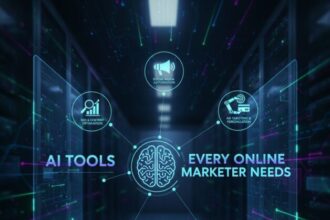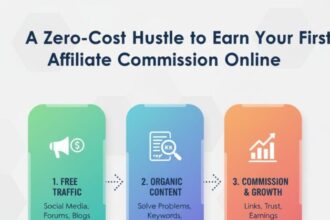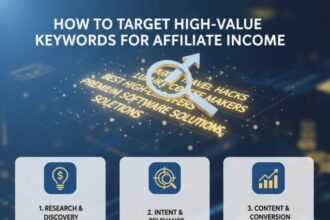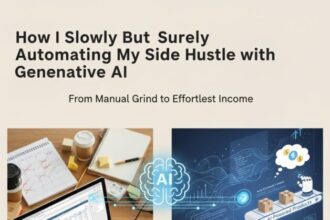My Accidental Side Hustle: How I Stumbled into Making Money with AI Without Even Trying
The email landed in my inbox at 10:17 AM on a Tuesday.
I remember the time because I was staring at the clock, trying to will it to be lunchtime. The subject line was just two words: “Project Payment.”
I squinted. I didn’t have any projects. My day job is… well, it’s a day job. It pays the bills. It’s fine. But it definitely does not involve getting mysterious “Project Payment” emails. I figured it was spam, another one of those fake invoices designed to give you a heart attack. So I hovered my mouse over the delete button.
But then I saw the amount. $300. And the sender’s name. It was a woman I’d had a brief, five-email exchange with a month ago. A conversation I had completely forgotten about. A conversation that started because of a weird little thing I’d posted online, something I’d made in a few spare hours on a Sunday afternoon.
My heart did a little thump-thump. This was real. I had just been paid for something I did for fun. Something I made with a tool I was just messing around with, a tool I barely understood. And in that moment, staring at that email, it slowly dawned on me. This is the story of how I accidentally built a side hustle using AI without planning to. I didn’t have a business plan. I didn’t have a strategy. I had a hobby, a little curiosity, and apparently, a new source of income.
It was the weirdest feeling in the world. And it all started because I was bored.
My Accidental Tumble Into the World of AI
Let’s be honest. I’m not a tech guy. My eyes glaze over when people start talking about algorithms or neural networks. I just nod along and hope nobody asks me a direct question.
So my journey into this whole AI thing didn’t start with some grand ambition. It started with me seeing all these cool images and weird text snippets popping up on social media. People were making stuff that looked… impossible. Fantastical art, poems that were actually pretty good, business ideas that were bizarrely specific.
I was curious. That’s all. So one weekend, I just decided to try one of these AI-powered tools. I signed up for a free trial of a popular AI image generator. My first prompts were ridiculous. “A raccoon riding a skateboard on the moon.” “A library made of gingerbread.” “A sad robot eating spaghetti in the rain.”
I was just playing. It felt like a video game. You type in some words, and this thing, this… digital genie… spits back a picture. It was fascinating. But it was also a glorious, confusing mess.
For every amazing image it created, it gave me ten that were just horrifying. Things with too many fingers, or faces that looked like they were melting. It didn’t feel like I was creating anything. It felt more like I was rolling dice and sometimes I got lucky.
My First Bot-Created Disasterpiece
After messing around with images, I got curious about the text-based AI. I thought, what if it could help me with a little project I was working on for a local animal shelter? They needed descriptions for the dogs up for adoption. I’m a terrible writer when I’m put on the spot. I always end up writing the same thing: “Is a good boy. Likes treats.”
So, I fed the AI some basic info about a beagle named Gus. Age, temperament, a few notes. I asked it to write a fun, heartwarming adoption bio. What I got back was… something else.
The AI wrote this epic, three-page saga about “Gustavus, the Hound of the Whispering Pines,” a mythical creature who had been “wronged by fate” and was seeking a “soul companion to share in the twilight of his years.” It was dramatic. It was ridiculous. And it was absolutely useless.
I laughed so hard I cried. My first attempt at using AI for something productive was a complete and utter failure. It was clear I had no idea what I was doing. I was just a kid with a new toy, pushing buttons to see what would happen. The idea of this ever turning into a passive income stream was so far from my mind it wasn’t even in the same galaxy.
Just Trying to Get a Handle on It
But I’m stubborn. The Gus disaster didn’t scare me off. It just made me more curious about how this thing actually thought. Why did it turn a normal beagle into a character from a fantasy novel?
I started reading, watching videos, and trying to understand the absolute basics. I learned that the AI is really just a super-advanced prediction machine. It’s been trained on a mind-boggling amount of text and images from the internet, and its whole job is to guess what should come next. A word after a word, or a pixel next to a pixel.
I started thinking of it less like a genie and more like a super-powered intern. An intern who has read every book ever written and seen every picture ever taken, but has absolutely no common sense.
You can’t just tell it, “Write me a blog post.” You have to guide it. You have to give it context, a specific tone of voice, examples of what you like. You have to manage it. Once I understood that, my relationship with it started to change. It went from being a weird toy to being… well, a tool. A very strange and powerful tool, but a tool nonetheless.
Turns Out, Everyone’s Got an Opinion About AI
Once I started getting the hang of things and making some stuff I was actually proud of, I started sharing it. Just casually, on my personal social media. A cool image I’d coaxed out of the AI, a piece of creative writing it had helped me brainstorm.
And that’s when the opinions started rolling in.
Man, people have feelings about AI. It was wild. I quickly realized that this wasn’t just a neutral topic. It was a minefield of hopes, fears, and really strong takes. It felt like everyone had already made up their mind about what this technology was and what it meant for the world. And a lot of what they thought, from my limited experience, just didn’t quite line up with what I was actually doing. It was time to do some myth-busting, at least for myself.
The ‘Robots Will Steal Your Soul’ Myth
The most common reaction I got was a kind of romantic fear. “Oh, I could never use that. It takes all the creativity out of it.” Or, “I just think art needs to come from a human soul.
I get it. I really do. I had that same thought at first. It feels a bit like cheating, doesn’t it?
But the more I used it, the more I realized that was the wrong way to look at it. The AI doesn’t have ideas. It doesn’t have a soul. It’s a machine. A very, very clever machine, but a machine. I was the one who had to come up with the initial concept. I had to decide if the output was good or garbage. I had to tweak the prompts, combine different outputs, and add my own human touch to make it something more than just a random generation.
It wasn’t replacing my creativity. It was just giving me a new starting point. I started thinking of it as a form of creative automation. It was automating the boring part—the blank page—so I could get to the fun part of refining and perfecting an idea faster. It wasn’t the painter; it was a new kind of paintbrush.
The ‘You Need to Be a Tech Bro’ Lie
The other thing I heard a lot was, “Wow, that’s so cool. I could never figure that out. It seems so technical.”
People seemed to think I was secretly a coder or some kind of tech wizard. I’m the guy who still has to call his nephew for help when the printer acts up. Trust me, I am not a tech wizard.
The truth is, these tools are being designed for regular people. You don’t need to know any code. You just need to know how to talk. If you can write a text message, you can write a prompt. There’s definitely a learning curve to getting good results, for sure. But the barrier to entry is incredibly low. It feels like the early days of digital photography. At first, it was this complex, expensive thing only pros used. Now, everyone has a supercomputer camera in their pocket. I think AI is heading in that same direction. It’s becoming more accessible every day.
The Myth That It’s Only for Making Money
This one is a little inside-out, but it’s important. I saw all these videos and posts about “How to Make $10,000 a Month with AI!” They made it sound like a get-rich-quick scheme. They were all about churning out soulless content, spamming Etsy with AI-generated art, and generally trying to make a quick buck.
And that just felt… gross. It completely missed the point of what I was enjoying about it.
For me, it was never about the money. I was having fun! I was exploring my own creativity in a way I never had before. It was a hobby. It was play. The idea of monetizing a hobby wasn’t even on my radar. I think this “playful” attitude was actually my secret weapon. Because I wasn’t trying to force it to make money, I was free to experiment, to make weird stuff, and to follow my own curiosity.
According to a piece in the Harvard Business Review, this kind of intrinsic motivation—doing something for the love of it—is often a key ingredient in breakthrough innovation. I wasn’t trying to innovate, but I was definitely having fun. And it turns out, that was way more important than having a business plan.
The Simple Shift That Made This Whole AI Thing ‘Click’ For Me
For a while, I was just a tinkerer. I was a guy with a new, weird hobby. I had folders full of strange images and documents filled with brainstorming sessions with my new robot friend.
But I still felt a little bit like an imposter. Was I really “creating” this stuff? Or was I just a glorified button-pusher? The whole thing felt a bit fuzzy, and I couldn’t quite articulate my relationship with this technology.
Then, one afternoon, I had my “aha!” moment. It wasn’t a lightning strike. It was a quiet shift in perspective. A new metaphor that finally made it all make sense. I realized the AI isn’t my intern. And it’s not my paintbrush.
It’s my co-pilot. Let that sink in for a second, because for me, it changed everything.
From Foe to Friend: It’s a Collaboration
A pilot can fly a plane alone. But a co-pilot makes the journey smoother, safer, and less exhausting. The co-pilot can handle the boring parts of a long flight, monitor the systems, and suggest alternative routes. But the pilot is always the one in charge. The pilot makes the final decisions. The pilot holds the ultimate responsibility for getting the plane to its destination.
That’s what using AI felt like for me.
I was the pilot. I had the destination in mind. I knew where I wanted to go creatively. The AI was my co-pilot. I could say to it, “Hey, I’m thinking of a story about a lonely lighthouse keeper. Give me ten possible character names.” And it would spit them out instantly. Nine might be terrible, but one might be perfect, something I never would have thought of on my own.
It was a partnership. A collaboration between my squishy, creative human brain and its silicon, data-crunching counterpart. This shift was massive. It took away all the guilt and imposter syndrome. I wasn’t cheating; I was collaborating. This process of AI content creation became a dialogue, not a command.
Finding the ‘Human-in-the-Loop’ Sweet Spot
This co-pilot idea helped me find what I now think of as the “human-in-the-loop” sweet spot.
I realized the best stuff I was making came from a constant back-and-forth. I’d generate an idea with the AI, then I’d take it and edit it myself. I’d write a paragraph, then I’d ask the AI to suggest three different ways to phrase it. I’d create an image, then I’d take that image into a photo editor and tweak the colors or combine it with another image.
My human judgment was always the final, most important ingredient. The AI was a powerful engine for generating raw material, but it was my taste, my curation, my storytelling ability that shaped it into something meaningful. It’s a bit like my overall approach to getting things done, which I’ve written about before in my post on my favorite productivity tools. You use the tools that work for you, but you’re always the one in charge. This realization was incredibly freeing. It gave me a framework. I wasn’t just pushing buttons anymore. I was directing a creative process. And that made all the difference.
My Messy, No-Nonsense Guide to How I Accidentally Built a Side Hustle Using AI Without Planning To
Okay, so this is the part where a real business guru would give you a slick, five-step plan to financial freedom.
I don’t have one of those. What I have is a messy, backward, stumbled-into-it story. This isn’t a “how-to” guide as much as a “how-I-did-it” tale. There was no grand strategy. But looking back, I can see the steps that led from that first goofy raccoon picture to that $300 email. So this is it. This is my personal, cobbled-together guide to my strange new reality. This is my entrepreneurial journey, even if I hate that word.
Step 1: I Found My Playground
First things first, I didn’t try to learn everything at once. The world of AI is huge and overwhelming. I just picked one thing that looked fun—image generation—and I played with it until I felt comfortable.
I wasn’t thinking about what was practical or profitable. I was thinking about what was cool. I followed my own curiosity. That was my only compass. For you, maybe it’s not images. Maybe it’s writing, or music, or code. It doesn’t matter. Find the playground that you genuinely enjoy.
Step 2: I Started Making Stuff for Fun, Not Money
For months, I just made things for an audience of one: me.
I created a whole series of images depicting historical figures in modern-day situations. I wrote short stories based on weird prompts. I designed logos for imaginary companies. I was building up my skills without the pressure of having to please a client or make a sale.
This is so, so important. This “no-pressure practice” is where you actually get good. It’s where you develop your own unique style and voice. If you jump straight to trying to sell stuff, you’ll probably just end up making generic things that look like everyone else’s.
Step 3: I Put My Stuff Out There (and Cringed)
This was the hardest part. Eventually, I got to a point where I thought, “Hey, this one is actually pretty good.” And with a deep breath and a lot of hesitation, I posted it online.
I didn’t have a professional portfolio or a fancy website. I just used my personal Instagram and a free portfolio site. I just wanted to put my work somewhere other than a folder on my desktop.
It felt incredibly vulnerable. But sharing your work is the only way anyone will ever see it. You have to be willing to put your creation out on the front porch for the neighbors to see. It’s a bit like my other work-from-home experiences; sometimes you just have to take a leap even if it feels awkward.
Step 4: The Email That Changed Everything
And then, one day, the magic happened. A woman who was a freelance graphic designer stumbled across one of my images on a portfolio site. She was swamped with work and needed some concept art for a client’s branding project. Fast.
She didn’t need a finished product. She just needed a bunch of high-quality, creative ideas to show her client to get the ball rolling. And she saw that I was able to generate a lot of unique ideas very quickly.
She sent me an email. She asked if I’d be willing to work with her on a small project. She offered me $300 to generate about 50 different visual concepts based on her creative brief. I was stunned. It was for offering freelance services I didn’t even know I had.
I said yes, of course. I did the work in about four hours. And that’s the story of the email that started it all. Since then, she’s come back for more work, and she’s referred me to two other people. It’s not a fortune. It’s not paying my mortgage. But it’s a real, legitimate side hustle. One that I never, ever planned on. And it fits perfectly into the modern gig economy that so many people are a part of, whether by choice or by necessity. There are entire platforms like Upwork built around this very idea of connecting skills to needs.
So, What’s the Takeaway From All This?
When I look back on the last six months, it all feels a bit surreal.
I didn’t set out to become a “freelance AI artist” or whatever you want to call it. I don’t have business cards. I still don’t really know what I’m doing half the time. But I’m making a little extra money doing something I genuinely find fun. And it’s taught me something important. Sometimes the best things in life aren’t planned. They’re stumbled upon.
This whole journey wasn’t about following a roadmap. It was about taking a walk in a new park, getting a little lost, and discovering a beautiful view I never knew existed. I wasn’t chasing a destination. I was just enjoying the walk.
I didn’t force it. I just followed the breadcrumbs of my own curiosity. It makes me wonder. What little hobby are you working on right now, just for the fun of it?
What if it’s the start of something you can’t even imagine yet?





































